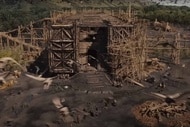Create a free profile to get unlimited access to exclusive videos, sweepstakes, and more!
We’re close to pulling an Indoraptor with the woolly mammoth… but should we?

Remember how Dr. Henry Wu, the same geneticist responsible for bringing T-Rex back to life in Jurassic Park, spliced together genes from both the extinct predator and extant animals like frogs and cuttlefish to create the infinitely more vicious Indominus Rex in Jurassic World? And how he pushed the Indominus thing even further in Jurassic World: Fallen Kingdom to spawn an Indoraptor that almost shredded humans and trashed an entire mansion?
Wu supposedly did this for science — and entertainment value. You can’t leave out the entertainment factor when you’re talking about creating the prima donna for a theme park that is supposed to make legions of visitors "ooh" and "aah" over resurrected species that clearly weren’t supposed to be there. But we might be edging towards that. Synthetic biologists of the Revive & Restore project may not be into killer reptiles (yet), but they are working on creating hybrid species by merging ancient and modern genomes.
Think Asian elephant DNA spliced with that of a woolly mammoth. That may not be such a fantastic idea.
Revive & Restore wants to re-populate what is known as the former “mammoth steppe” in Siberia with something as close to a mammoth as possible. The goal is supposedly to reintroduce a species that hasn’t been around since the Pleistocene Epoch to an ecosystem it hasn’t called its stomping grounds in 10,000 years. There is some uncertainty as to how the mammoth went extinct to begin with. Some think humans hunted it nearly to extinction, while others blame it on a seismic shift in climate.
What's haunting us is whether humans alive right now should be hybridizing a species extinct for aeons just because of guilt for our ancestors. That aside, some scientists believe resurrecting dead furry elephant-creatures will not only restore the ecosystem to what it once was, but teach us things we only could have learned otherwise with a time machine. Others argue that these are just excuses to show off what science can do but not necessarily what it should do. Wu’s Indominus Rex and Indoraptor were clearly hatched from that kind of mindset.
Then there is the whole issue of whether the ecosystem really will go back to what it was with the reemergence of something that may be better off extinct.
Beth Shapiro, evolutionary microbiologist at UC Santa Cruz and author of the book How To Clone a Mammoth: The Science of De-Extinction, is the type of scientist who would challenge the motives of the fictional Wu. She believes the technologies that are being used to resurrect animals that have been gone for way too long should instead go towards saving those on the edge of extinction. What about the white rhino? The Malayan tiger? The kakapo?
“We have these big brains that have allowed us to make flint technology and 747s and now CRISPR,” she told Gizmodo. “We can also use our big brains to think about consequences and think long-term. We have the capacity to plan for the future, so let’s do that.”
Forget a herd of mammoths; we’re we’re still far from replicating an entire mammoth cell, let alone an entire animal. But our own species ought to think twice before we unleash an Indomammoth.
(via Gizmodo)














